Silex technology N6C-SXSDCAG User manual
- Category
- Network antennas
- Type
- User manual
This manual is also suitable for

SX-SDCAG 802.11a/b/g SDIO Module
User Manual
140-00197-100 Rev A

140-00197-100 Revision A
© 2010 Silex Technology America, Inc. All rights reserved.
February 2010
Silex Technology America SPECIFICALLY DISCLAIMS THE IMPLIED WARRANTIES OF MERCHANTABILITY AND
FITNESS OF THIS PRODUCT FOR A PARTICULAR PURPOSE. Silex shall not be liable for any errors contained in this
manual or for any damages resulting from loss of use, data, profits, or any incidental or consequential damages arising from
the use of SILEX products or services. The information contained in this documentation is subject to change without notice.
Information and descriptions contained herein are the property of Silex. Such information and descriptions may
not be copied, disseminated, or distributed without the express written consent of Silex. This publication is
subject to change without notice.
Trademarks
ExtendView is a trademark of Silex Technology America, Inc. All other company or product names referenced
in this document may be trademarks or registered trademarks of their respective owners.
Silex Technology America, Inc.
www.silexamerica.com

Contents Silex Page 1
140-00197-100 Revision A
Contents
About This User Manual............................................................................................................................................ 2
Safety Precautions................................................................................................................................................. 2
Emissions Disclaimer............................................................................................................................................. 2
Chapter 1: Introduction.............................................................................................................................................. 3
Chapter 2 Hardware Specifications/Compliance....................................................................................................... 4
FCC Information..................................................................................................................................................... 4
Information for Canadian Users (IC Notice)........................................................................................................... 5
Specifications......................................................................................................................................................... 7
Chapter 3 Installation................................................................................................................................................. 8
Installation Requirements ...................................................................................................................................... 8
Installation Procedure............................................................................................................................................ 8
Appendix A Antenna Information............................................................................................................................. 10
Antenna Specifications ........................................................................................................................................ 10
Appendix B Silex Contact Information..................................................................................................................... 12

Page 2 Silex About This User Guide
140-00197-100 Revision A
About This User Manual
This user manual provides detailed specifications, diagrams and additional information required to install the SX-
SDCAG 802.11a/b/g SDIO module into a product. The intended audiences are the developers and engineers
responsible for the integration of the module in another product.
Safety Precautions
To prevent damage to the SX-SDCAG module’s electronic circuit components, follow established
ESD practices and procedures for handling static-sensitive devices. All ESD-sensitive components must be
stored and shipped in ESD-conductive bags or bubble-wrap and labeled as such using the standardized
ESD adhesive warning label.
Ethernet electrical wiring must be at least 6 feet from bare power wiring or lightning rods and
associated wires, and at least 6 inches from other types of wire (antenna wires, doorbell wires, wires from
transformers to neon signs), steam or hot water pipes, and heating devices.
Protectors and grounding wire placed by the service provider must not be connected to, removed,
or modified by the customer.
Emissions Disclaimer
Final emission certification per FCC, IC, CE and other agency requirements are the responsibility of the OEM
(refer to chapter 2 for additional information).

Introduction Silex Page 3
140-00197-100 Revision A
Chapter 1: Introduction
The SX-SDCAG is an 802.11a/b/g radio/baseband module in a standard SDIO form factor.
Designed for wireless local area network (WLAN) applications that require low power
consumption, the SX-SDCAG is ideal for battery-operated portable devices in the medical,
weights and measures, transportation and other industries.
SX-SDCAG features include:
• Highly Integrated System for 802.11a/b/g WLAN
• U.FL antenna connectors with diversity support
• Wide operating temperature range
• Integrated Atheros AR6002XZ Single Chip
• Integrated high performance Dual-Band Front End Module (FEM), Band Pass Filter,
26MHz Crystal
• 16Kbit EEPROM
• Advanced power management to minimize standby and active power
• WEP 64/128, WPA (TKIP), WPA2 (802.11i) security
• Linux, Windows CE, and Windows Mobile drivers available from Silex (porting will be
required in most cases)
Figure 1 SX-SDCAG Dimensions (mm)
24.0
1.5
46.0
4.1
27.1

Introduction Silex Page 4
140-00197-100 Revision A
Chapter 2
Hardware Specifications/Compliance
FCC Information
FCC ID: N6C-SXSDCAG
NOTICE
In accordance with FCC Part 15, the SX-SDCAG is listed as a Modular Transmitter device. End products
that include the SX-SDCAG shall have the words “Contains Transmitter module FCC ID: N6C-
SXSDCAG” on an exterior label.
This equipment complies with Part 15 of the FCC Rules. Operation is subject to the following two
conditions: (1) this device may not cause harmful interference, and (2) this device must accept any
interference received, including interference that may cause undesired operation.
This equipment has been tested and found to comply within the limits for a Class B digital device,
pursuant to part 15 of the FCC Rules. These limits are designed to provide reasonable protection against
harmful interference in a residential installation.
This equipment generates, uses, and can radiate radio frequency energy and, if not installed and used in
accordance with the instructions, may cause harmful interference to radio communications. However,
there is no guarantee that interference will not occur in a particular installation. If this equipment does
cause harmful interference to radio or television reception, which can be determined by turning the
equipment off and on, the user is encouraged to try to correct the interference by one or more of the
following measures:
• Reorient or relocate the receiving antenna
• Increase the separation between the equipment and receiver
• Connect the equipment into an outlet on a different circuit from that to which the receiver is
connected
• Consult the dealer or an experienced radio/TV technician for help.
The transmitter must not be co-located or operated in conjunction with any other antenna or transmitter.
In accordance with 15.407(e), within the 5.15 – 5.25 GHz band, this device must be restricted to indoor
use to reduce any potential for harmful interference to co-channel Mobile Satellite Systems.

Specifications/Compliance Silex Page 5
140-00197-100 Revision A
The available scientific evidence does not show that any health problems are associated with using low
power wireless devices. There is no proof, however, that these low power wireless devices are absolutely
safe. Low power wireless devices emit low levels of radio frequency energy (RF) in the microwave range
while being used. Whereas high levels of RF can produce health effects (by heating tissue), exposure to
low-level RF that does not produce heating effects causes no known adverse health effects. Many
studies of low-level RF exposures have not found any biological effects. Some studies have suggested
that some biological effects might occur, but such findings have not been confirmed by additional
research.
To satisfy RF exposure requirements, this device and its antenna(s) must operate with a separation
distance of at least 20 centimeters from all persons and must not be co-located or operated in conjunction
with any other antenna or transmitter. End-users must be provided with specific operating instructions for
satisfying RF exposure.
FCC WARNING:
Changes or modifications not expressly approved by the party responsible for compliance could void the
user’s authority to operate the equipment.
Information for Canadian Users (IC Notice)
The term “IC” before the radio certification number only signifies that Industry Canada technical
specifications were met. Operation is subject to the following two conditions: (1) this device may not
cause interference, and (2) this device must accept any interference, including interference that may
cause undesired operation of the device.
This Class B digital apparatus meets all requirements of the Canadian Interference-Causing Regulations.
I. The device for the band 5150-5250MHz is for indoor usage to reduce potential for harmful
interference to co-channel Mobile Satellite systems.
II. The maximum antenna gain permitted (for devices in the bands 5250-5350 MHz and 5470-
5725 MHz) to comply with the e.i.r.p. limit
III. The maximum antenna gain permitted (for devices in the band 5725-5825 MHz) to
comply with the e.i.r.p. limits specified for point-to-point and non point-to-point operation as
appropriate, as stated in section A9.2(3).
Users should be cautioned to take note that high-power radars are allocated as primary users (meaning
they have priority) of the bands 5250-5350 MHz and 5650-5850 MHz and these radars could cause
interference and/or damage to LE-LAN devices.
To prevent radio interference to the licensed service, this device is intended to be operated indoors and
away from windows to provide maximum shielding. Equipment that is installed outdoors is subject to
licensing.
This device has been designed to operate with the antennas listed below, and having a maximum gain of
3.2dB @ 2.4 GHz and 4.2 dB @ 5 GHz. Antennas not included in this list or having a higher gain are
strictly prohibited for use with this device. The required antenna impedance is 50 ohms.
• Ethertronics Prestta WLAN Embedded Antenna, Part No. 1000418
• Pulse Engineering Dualband WLAN Ceramic Chip Antenna, Part No. W3006
To reduce potential radio interference to others, the antenna type and its gain should be so chosen that
the equivalent isotropically radiated power (EIRP) is not more than required for successful
communication.
The available scientific evidence does not show that any health problems are associated with using low
power wireless devices. There is no proof, however, that these low power wireless devices are absolutely

Page 6 Silex Specifications/Compliance
140-00197-100 Revision A
safe. Low power wireless devices emit low levels of radio frequency energy (RF) in the microwave range
while being used. Whereas high levels of RF can produce health effects (by heating tissue), exposure to
low-level RF that does not produce heating effects causes no known adverse health effects. Many
studies of low-level RF exposures have not found any biological effects. Some studies have suggested
that some biological effects might occur, but such findings have not been confirmed by additional
research.

Specifications/Compliance Silex Page 7
140-00197-100 Revision A
Specifications
Operating environment: Temperature: -20º to +70ºC (-4º to +158ºF)
Humidity: 20% to 80%
Storage environment: Temperature: -30º to +85ºC (-22º to +185ºF)
Humidity: 20% to 85%
Supply voltage: 3.3V ± 5%
Host interface: SDIO
IEEE 802.11b Frequency: 2412MHz-2462MHz
Transmission system: DSSS
Transmission speed: 1/2/5/11Mbps
Automatic detection
Channel: 1-11
IEEE 802.11g Frequency: 2412MHz-2462MHz
Transmission system: OFDM
Transmission speed: 6/9/12/18/24/36/48/54Mbps
Automatic detection
Channel: 1-11
IEEE 802.11a Frequency: 5180MHz-5240MHz, 5745-5825MHz
Transmission system: OFDM
Transmission speed: 6/9/12/18/24/36/48/54Mbps
Automatic detection
Channel: 36-48, 149-165

Installation Silex Page 8
140-00197-100 Revision A
Chapter 3
Installation
Installation Requirements
The SX-SDCAG must be installed in a device that contains a 9-pin SDIO slot.
The SX-SDCAG has FCC limited single modular approval, which can eliminate the need for you to obtain
FCC Part 15 Subpart C and E (intentional radiation) approvals for your device. In order to use this FCC/IC
limited single modular approval for the SX-SDCAG, OEM integrators must:
1. include “Contains FCC ID: N6C-SXSDCAG, IC: 4908B-SXSDCAG” on the exterior label of your
device.
2. ensure for use in the United States and Canada that the driver for the SX-SDCAG in your product
disables scanning on channels 12-14, 50-70 and 80-144 by loading a table with disabled
channels into the SX-SDCAG during initialization.
3. ensure the driver does not permit use of channels 12-14, 50-70 and 80-144 in ad-hoc mode in the
United States and Canada by using the same disabling method.
4. use an antenna referred to in appendix A or an equivalent type antenna with equal or lower gain.
5. include all required statements in your final product user’s manual (per 15.21, 15.27, 15.105,
15.407(e), etc) and final product labeling (per 15.19). Refer to FCC/IC Information in previous
chapter.
6. include following statement “In accordance with 15.407(e), within the 5.15 – 5.25 GHz band, this
device must be restricted to indoor use to reduce any potential for harmful interference to co-
channel Mobile Satellite Systems.”
7. not provide Instructions on how to remove or install the SX-SDCAG to your end users.
8. provide regulated +3.3 VDC +/- 5% power to the SX-SDCAG.
If you do not follow the above instructions, then it is your responsibility to obtain the necessary FCC
approvals.
Installation Procedure
To install the SX-SDCAG:
1. Be sure to use the proper antistatic handling techniques.

Specifications/Compliance Silex Page 9
140-00197-100 Revision A
2. Connect one end of the antenna cable to the main antenna connector on the SX-SDCAG (see
figure 2). If you are using a diversity antenna configuration, connect one end of the second
antenna cable to the secondary antenna on the SX-SDCAG.
Figure 2. Connecting the Antenna(s) and cable(s) to the SX-SDCAG
3. Insert the SX-SDCAG into an available SDIO slot in your device. Make sure that it is securely
seated.
4. If your device is subject to significant vibration or other forces, Silex recommends securing the
SX-SDCAG using the corner mounting hole with a screw to prevent the accidental ejection of the
card.
Figure 3. Securing the SX-SDCAG
M2 Screw

Antenna Information Silex Page 10
140-00197-100 Revision A
Appendix A
Antenna Information
Antenna Specifications
Please refer to the Ethertronics website @ www.ethertronics.com for more detailed information for the
Prestta WLAN Embedded Antenna, Part No. 1000418.
Table 1 Electrical Specifications
Parameter Value
Antenna Type Isolated Magnetic Dipole
Frequency Range 2.4 to 5.8 GHz
Impedance 50 Ohms
Gain (peak) 2.4 GHz = 2.5 dBi
5.8 GHz = 3.5 dBi
VSWR
≤ 2.0
Standard Connector U.FL Micro Coaxial

Antenna Information Silex Page 11
140-00197-100 Revision A
Please refer to the Pulse website @ www.pulseeng.com/antennas
for more detailed information for the
Pulse Dualband WLAN Ceramic Antenna, Part No. W3006.
Table 2 Electrical Specifications
Parameter Value
Antenna Type High-Dielectric Monopole
Frequency Range 2.4 to 5.8 GHz
Impedance 50 Ohms
Gain (peak) 2.4 GHz = 3.2 dBi
5.8 GHz = 4.2 dBi
VSWR
≤ 2.0
Standard Connector U.FL Micro Coaxial

Antenna Information Silex Page 12
140-00197-100 Revision A
Appendix B
Silex Contact Information
Silex Technology America, Inc.
www.silexamerica.com
Technical Support: support@silexamerica.com
Sales: sales@silexamerica.com
Tel: (801) 748-1199 8:00 to 5:00 Mountain Time
Tel: (866) 765-8761 toll-free
Fax: (801) 748-0730
Silex Technology Europe GmbH
www.silexeurope.com
Tel: +49-2159-67500
Tel: 0800-7453938 German toll free
Email: [email protected]
Silex Technology Beijing, Inc.
www.silex.com.cn
Tel: +86-10-8497-1430
Email: contact@silex.com.cn
Corporate Headquarters
Silex Technology, Inc.
www.silex.jp
Tel: +81-6-6730-3751
Email: [email protected]
Silex
Technology America, Inc.
www.silexamerica.com
-
 1
1
-
 2
2
-
 3
3
-
 4
4
-
 5
5
-
 6
6
-
 7
7
-
 8
8
-
 9
9
-
 10
10
-
 11
11
-
 12
12
-
 13
13
-
 14
14
Silex technology N6C-SXSDCAG User manual
- Category
- Network antennas
- Type
- User manual
- This manual is also suitable for
Ask a question and I''ll find the answer in the document
Finding information in a document is now easier with AI
Related papers
-
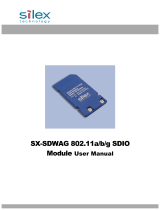 Silex technology SX-SDWAG User manual
Silex technology SX-SDWAG User manual
-
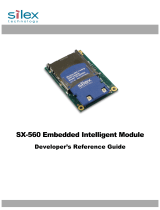 Silex technology Embedded Intelligent Module SX-560 User manual
Silex technology Embedded Intelligent Module SX-560 User manual
-
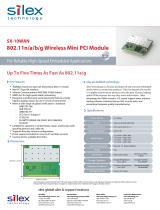 Silex technology Wireless Mini PCI Module SX-10WAN User manual
Silex technology Wireless Mini PCI Module SX-10WAN User manual
-
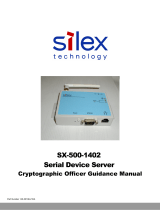 Silex technology Server SX-500-1402 User manual
Silex technology Server SX-500-1402 User manual
-
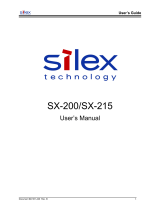 Silex technology SX-215 User manual
Silex technology SX-215 User manual
-
Silex technology X-5 User manual
-
Silex technology SX-590 User manual
-
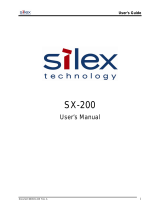 Silex technology N6C-SX-200 User manual
Silex technology N6C-SX-200 User manual
-
Silex technology SX-500 Series User guide
-
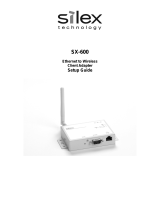 Silex technology SX-600 User manual
Silex technology SX-600 User manual




















